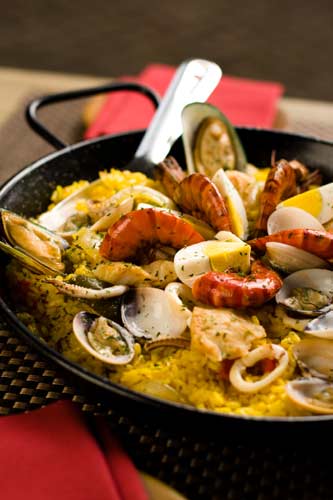说到美食,各国似乎都有一种或几种代表性菜品。比如中国的的饺子、日本的寿司、韩国的拌饭、意大利的比萨、巴西的烤肉……但说到西班牙美食,许多人可能并不熟悉,那下面我们就来了解一下它最具本土特色的一道美食吧!

By Padrick Clancy
卓言 选 晓凯 译
|
Paella is currently an internationally-known dish from Spain. It originated in the fields of a region called Valencia in eastern Spain. Today paella is made in every region of Spain, using just about any kind of ingredient that goes well with rice. There are as many versions of paella as there are cooks. It may contain chicken, pork, shellfish, fish, eel, squid, beans or peppers. There is an old story saying that the Moorish kings’ servants created rice dishes by mixing the left-overs from royal banquets in large pots to take home. It is said by some that the word paella originates from the Arab word baqiyah meaning left-overs. However, linguists believe that the word paella comes from the name of the pan it is made in—the Latin term patella, a flat plate on which offerings were made to the Gods. The stories of servants creating dishes from the King’s left-overs are romantic, but it is known for certain that it was not until the mid-nineteenth century that modern paella was created in an area around Albufera (a bay south of Valencia). At lunch time, workers in the fields would make the rice dish in a flat pan over a fire. They mixed in whatever they could find—such as snails and vegetables. For special occasions, rabbit and later chicken were added. Olive oil is basic to paella. So is saffron, a very expensive spice. This precious spice, the dried stigmas of a summer-blooming crocus that is one of Spain’s most important crops (it takes the stigmas of 75,000 crocuses to make one pound of the spice), gives paella and other dishes their characteristic bright yellow color, and more importantly a distinctive flavor. If real saffron is not available, use yellow food coloring plus paprika to give it a sunny yellow color. The type of rice is also critical. The traditional Valencia rice, the one used for paella, is a round, medium-short grain rice. It has a marvelous capacity for absorbing the flavours with which it cooks—chicken, pork, olive oil, seafood, vegetables. There is nothing more agreeable than a paella picnic, when everyone crams themselves into cars, the boots laden with food and drink, to bump their way down to a favourite beach or up into the mountains. There, wood is gathered for the fire and olives and sausage are nibbled, while discussion rages over the rice, glistening yellow and bubbling in the warm air. It is the most enjoyable of occasions. |
海鲜饭如今已成为一道驰名国际的西班牙美食。它起源于西班牙东部巴伦西亚地区的田间。今天西班牙各个地区都有海鲜饭,任何可以跟米饭搭配的食材都可以用来做这道饭。海鲜饭的做法多样,可以说有多少厨师就有多少种做法。饭里可以有鸡肉、猪肉、贝及甲壳类肉、鱼肉、鳗鱼、鱿鱼、豆类或胡椒粉。 有个古老的传说,摩尔国王的仆人们将宫廷宴会上的剩饭菜混在一起放在大锅里带回家,由此就做成了海鲜饭。还有人认为,海鲜饭的西班牙语paella源自阿拉伯语的baqiyah,意思就是“残羹剩菜”。然而,语言学家们则认为paella这个词来源于做海鲜饭用的平底锅名称——即拉丁语patella,敬献诸神的供品一般都盛放在这种平底容器上。 仆人们用国王的残羹剩菜做成一道饭的故事颇具浪漫色彩,不过,确凿的一点是,直到19世纪中期,现代的海鲜饭才在阿尔布法罗(巴伦西亚南部的一个海湾)附近的地区出现。午饭时,田地里的工人们把平底锅放在火上做海鲜饭。他们把所有能找到的食材——如蜗牛和蔬菜——都放进去。在特殊的场合,饭里会加入兔肉,后来还加入了鸡肉。 橄榄油是海鲜饭的基本佐料。另外还有藏红花,是一种非常昂贵的香料。这种珍贵的香料其实是干藏红花的柱头,在夏季开放的藏红花是西班牙最重要的作物之一(一磅的这种香料大概需要75,000朵藏红花的柱头);这种香料令海鲜饭和其他菜肴都呈现出特有的亮黄色,更重要的是还添加了一种独特的风味。如果没有真的藏红花,用黄色料加上辣椒粉也可令其呈现出金黄色。另外对大米的选用也很挑剔。做海鲜饭要用传统的巴伦西亚大米,米粒呈圆形、大小中等。这种大米能够很好地吸收和它一起烹调的食材的味道,如鸡肉、猪肉、橄榄油、海鲜和蔬菜。 当所有人都挤进车子里,后备箱塞满食物和饮料,一路颠簸着来到最爱的一处海滩或是山上时,没有什么比一顿海鲜饭野餐更怡人的了。在那里,人们堆起木头生起火,一边吃着橄榄果和香肠,一边高谈阔论,身边是在温暖的空气中咕嘟作响的海鲜饭,泛着亮闪闪的黄色。这可真是最令人愉快的享受时刻啊! (来源:英语学习杂志) |
|
Vocabulary: boot 〈英〉(一般设在汽车后部的)行李箱 Moorish 摩尔人的。摩尔人(Moor)指非洲西北部阿拉伯人与柏柏尔人的混血后代,公元8世纪成为伊斯兰教徒,进入并统治西班牙 nibble 一点一点地咬(或吃) paella 海鲜饭,西班牙饭食,是一种平锅菜饭,用番红花调味的大米与肉类、海鲜、蔬菜、香料等烹调而成 rage 激烈进行 stigma 柱头 |